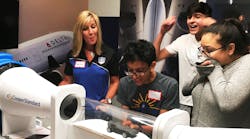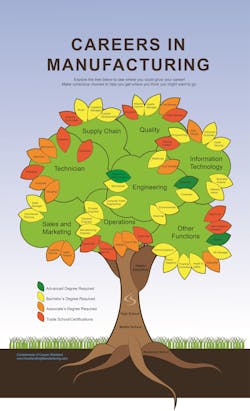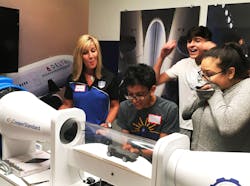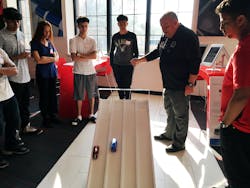Addressing STEM’s “Skills Gap” by Closing the “Interest Gap”
Over the next decade, nearly 3.5 million manufacturing jobs will be needed, with 2 million expected to go unfilled due to the skills gap. Further, 80% of manufacturers already report a moderate or serious shortage of qualified applicants for skilled and highly skilled production positions. (Source: NAM/Deloitte and the Manufacturing Institute)
Some would call this a crisis, an understandable sentiment given manufacturing contributed $2.25 trillion to the U.S. economy in 2016—a figure that has continually risen since the second quarter of 2009.
But, what is a crisis to some is seen as an opportunity for others.
That was just the case for two Michigan organizations that have come together to make a positive change for their local communities. In 2017, Junior Achievement of Southeastern Michigan and Cooper Standard partnered together to create a STEM education program, recognizing that the highly publicized skills gap is really rooted in an interest gap with students. The goal of the program is to inspire and educate middle and high school students to consider STEM-related careers. The program will reach approximately 3,000 students throughout southeast Michigan each year and has generated overwhelming interest from students, teachers, and program volunteers.
Cooper Standard’s “Careers in Manufacturing” tree illustrates the many job opportunities in STEM fields, especially those in manufacturing.
Fostering the Next-generation Workforce
Junior Achievement of Southeastern Michigan and Cooper Standard share a passion for creating and fostering positive change. For more than 70 years, Junior Achievement of Southeastern Michigan has worked in partnership with its communities to transform the student experience by bringing relevance, authenticity, and application into learning to energize students around academics and their future. Cooper Standard is a global automotive supplier with an engaged workforce, culture of community service, and history of philanthropy. Since April 2013, the Company’s charitable foundation—the Cooper Standard Foundation—has provided $10 million to more than 100 organizations across 16 countries.
Last year, the two organizations came together to discuss how to further inspire student interest in STEM-related careers, especially in manufacturing. They also wanted to help companies in their local communities fill their talent pipeline with an educated and engaged workforce.
Together they developed JA STEMworks!, a program designed to introduce middle and high school students to a variety of STEM-related careers. Available through the local school system, JA STEMworks! is facilitated by professionals currently working in STEM-related careers. These individuals guide students through STEM activities and talk to them openly, relating the activities to real-life careers.
Students in the program design model racecars, which are then tested, weighed, and put into a small wind tunnel created by Cooper Standard engineers.
Prior to their day at Junior Achievement, students receive several hours of classroom instruction preparing them for the experience. This additional classroom content and attention to detail is the JA STEMworks! difference. Then, throughout a daylong session, the student participants experience a variety of STEM activities developed by Cooper Standard engineers to simulate real-life working environments. These activities include:
- Mass: adding and subtracting weight and its impact on racing;
- Friction: working with various materials to learn resistance;
- Wind: taking part in a wind tunnel experiment;
- Design: working with modeling clay; and
- TinkerCAD: experimenting with Computer Aided Design (CAD).
Cooper Standard, which funds the program through the Cooper Standard Foundation, designed the experiments based on the Company’s successful STEM outreach program. The sessions provide students a reminder of some of the STEM basics they have learned throughout their scholastic career while incorporating new lessons in a fun and interactive way, all while tying these activities to real-life job functions.
For example, during the Mass session, students physically add weights to cars and witness the impact it has on their speed; all the while, the facilitator is explaining how the weight also affects the fuel efficiency of a vehicle and the specific techniques engineers and designers use to maximize both. The students begin to really see the correlation between the activities and the real-life application of the lessons.
Each activity is a building block of knowledge, showing students how each component of design impacts the performance of a vehicle. As students rotate through each experiment, they are often surprised to learn that there are many careers tied to each topic that they may not have considered. One fun fact that often appeals to artistic students is that graduates of the Detroit College for Creative Studies are some of the most sought-after clay modelers for design.
In the afternoon session, the participants have the opportunity to put their new knowledge to the test. The students are separated into teams charged with building racecars with Legos and modeling clay using the knowledge they have learned that morning. Everyone on the team has a role in the process—project manager, designer, quality controller, etc.—to simulate a real collaborative working environment. The model racecars are then tested, weighed, and put into a small the wind tunnel created by Cooper Standard engineers prior to racing other teams’ cars.
The model car racing is the highlight of the day for students and volunteers alike; pride and confidence soar as students put their newly acquired skills to work. The session closes with an open discussion between students and professionals who currently work in STEM-related careers.
Closing the Interest Gap
While there are several programs that focus on different parts of STEM education, another unique element of this program is that it enables students the opportunity to learn about specific STEM careers as they go throughout their day. This is a critical component to JA STEMworks!, as it works to increase the younger generation’s awareness of and interest in STEM-related careers.
Although many students enjoy STEM-related activities and projects, there is a current misconception that some STEM jobs, such as those in manufacturing, are “boring.” Another common misconception is that all STEM careers require at least a four-year college degree, which isn’t accurate. Yet another is that today’s manufacturing industry looks the same as it did 20 years ago, with workers performing monotonous jobs in dark and dirty factories. In reality, technology and automation have drastically transformed the industry into a cutting-edge career choice.
Working to close this interest gap, during JA STEMworks!, every activity is tied back to a STEM career that the students can aspire to in real life. For example, modern manufacturing offers many diverse career opportunities. From production to product engineering—and other supportive roles, from communications to purchasing—there are countless options across all levels of education.
To help highlight this expansive array of career paths, students are provided an information packet at the end of the day with a list of approximately 26 STEM-related career choices. The students also have access to Cooper Standard’s “Careers in Manufacturing” tree that illustrates the many job opportunities in STEM fields, especially as it relates to modern manufacturing, along with the various levels of education needed to obtain these positions.
At the end of the session, students leave inspired and engaged. The initial feedback has been overwhelmingly positive with students eager to learn more. According to student surveys, 72% of the students said they are interested in pursuing a STEM-related career as a result of their day.
Real-Life Mentors
The students are separated into teams charged with building racecars with Legos and modeling clay using the knowledge they have learned from the program.
Another way JA STEMworks! helps to close the interest gap is through its volunteers. While these participants vary from week to week and session to session, they share one important attribute: All are currently working in a STEM field. This is an important feature of the program, as it provides the session attendees exposure to different careers and job opportunities through someone who works in the field every day.
The volunteer group, usually about 15 to 20 professionals working with a group of 50 student participants, come from a number of notable, forward-thinking companies, such as Ford Motor Co., General Motors Co., and Inforum’s INSTEM program. While individual employee volunteer opportunities are always available, most companies opt to create a team-building opportunity by sending a group of employees.
Volunteers are provided with a packet ahead of time that provide lessons on each of the sessions, as well as a “what to expect” guide that answers frequently-asked questions and the day’s agenda. Volunteers arrive on-site approximately one hour prior to the students to allow JA to share a brief training video put together by Cooper Standard, walk them through their day, and answer any questions. The students love getting to know these professionals and hearing about both their successes and failures.
In addition to fostering the next-generation workforce, Cooper Standard cites employee engagement as a key benefit of the program, and one of the reasons why the company chose to develop the program with Junior Achievement of Southeastern Michigan. According to feedback, employees are excited to know that these types of volunteer opportunities exist and that their company is working to engage the next-generation workforce. Employees also value the opportunity to meet and develop relationships with peers from other areas of the company, which is often challenging to do as today’s work environment becomes more global and remote.
For Cooper Standard, these benefits help foster the company’s established culture of community engagement and investing in the communities where its employees and customers work and live. These are important factors, as they work to hire younger associates who consider an organization’s culture when evaluating job opportunities.
Just Do It
Based on the high level of response from both volunteers and schools, Junior Achievement of Southeastern Michigan will increase its sessions to twice a month for the 2018-2019 school year, with the intention of growing to three times a month by the end of 2019.
There is a great need for STEM-education support and many opportunities for companies to become involved. For those considering joining the effort, Junior Achievement of Southeastern Michigan and Cooper Standard encourage companies to just do it! Both organizations stress that interested companies don’t need to reinvent the wheel and create a program from scratch. There are a number of great STEM education programs currently available, so take the first step by collaborating with an established program. The next-generation workforce will thank you.
Jennifer Shupp is director of business development at Cooper Standard. Jennifer Champion is vice president of development and marketing at Junior Achievement of Southeastern Michigan.




